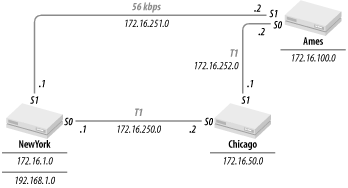Chapter 2. Routing Information Protocol (RIP)
RIP is the first in a family of dynamic routing protocols that we will look at closely. Dynamic routing protocols automatically compute routing tables, freeing the network administrator from the task of specifying routes to every network using static routes. Indeed, given the complexity of and number of routes in most networks, static routing usually is not even an option.
In addition to computing the “shortest” paths to all destination networks, dynamic routing protocols discover alternative (second-best) paths when a primary path fails and balance traffic over multiple paths ( load balancing).
Most dynamic routing protocols are based on one of two distributed algorithms: Distance Vector or Link State. RIP, upon which Cisco’s IGRP was based, is a classic example of a DV protocol. Link State protocols include OSPF, which we will look at in a later chapter. The following section gets us started with configuring RIP.
Getting RIP Running
Throughout this book, we’ll be using a fictional network called TraderMary to illustrate the concepts with which we’re working. TraderMary is a distributed network with nodes in New York, Chicago, and Ames, Iowa, as shown in Figure 2-1.

Figure 2-1. TraderMary’s network
As a distributed process, RIP needs to be configured on every router in the network:
hostname NewYork ... interface Ethernet0 ip address 172.16.1.1 ...
Get IP Routing now with the O’Reilly learning platform.
O’Reilly members experience books, live events, courses curated by job role, and more from O’Reilly and nearly 200 top publishers.

